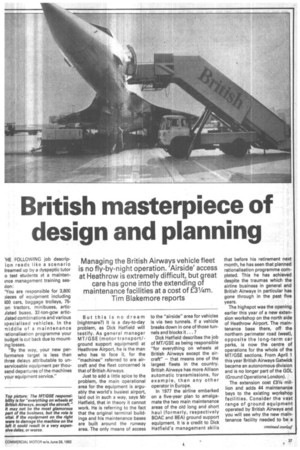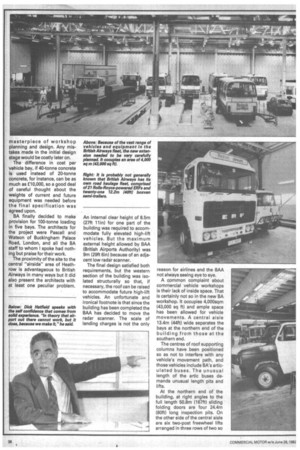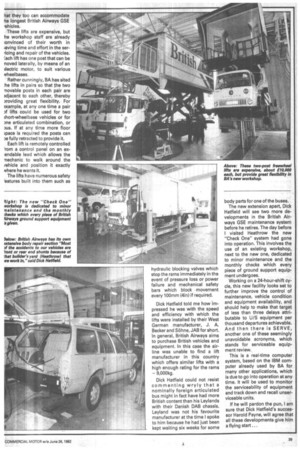British masterpiece of design and planning
Page 27

Page 28

Page 29

If you've noticed an error in this article please click here to report it so we can fix it.
Managing the British Airways vehicle fleet is no fly-by-night operation. 'Airside' access at Heathrow is extremely difficult, but great care has gone into the extending of maintenance facilities at a cost of £31/4m. Tim Blakemore reports
HE FOLLOWING job descripion reads like a scenario ireamed up by a dyspeptic tutor o test students at a maintenince management training ses;ion: 'You are responsible for 3,80C )ieces of equipment including 1.00 cars, baggage trolleys, 75on tractors, minibuses, articilated buses, 32-ton-gcw articilated combinations and various ;pecialised vehicles. In the middle of a maintenance rationalisation programme your budget is cut back due to mounting losses.
"By the way, your new performance target is less than three delays attributable to unserviceable equipment per thousand departures of the machines your equipment service." But this is no dream (nightmare?) It is a day-to-day problem, as Dick Hatfield will testify. As general manager MT/GSE (motor transport!ground support equipment) at Heathrow Airport, he is the man who has to face it, for the "machines" referred to are aircraft and the fleet concerned is that of British Airways.
Just to add a little spice to the problem, the main operational area for the equipment is arguably the world's busiest airport, laid out in such a way, says Mr Hatfield, that in theory it cannot work. He is referring to the fact that the original terminal buildings and his maintenance bases are built around the runway area. The only means of access to the "airside" area for vehicles is via two tunnels. If a vehicle breaks down in one of those tun nels and blocks it ?
Dick Hatfield describes the job of MT/GSE as being responsible "for everything on wheels at British Airways except the aircraft" — that means one of the largest fleets in the country. British Airways has more Allison automatic transmissions, for example, than any other operator in Europe.
In 1977 the airline embarked on a five-year plan to amalgamate the two main maintenance areas of the old long and short haul (formerly, respectively BOAC and BEA) ground support equipment. It is a credit to Dick Hatfield's management skills that before his retirement next month, he has seen that planned rationalisation programme completed. This he has achieved despite the traumas which the airline business in general and British Airways in particular has gone through in the past five years.
The highspot was the opening earlier this year of a new extension workshop on the north side of Heathrow Airport. The maintenance base there, off the northern perimeter road (west), opposite the long-term car parks, is now the centre of operations for the whole of the MT/GSE sections. From April 1 this year British Airways Gatwick became an autonomous division and is no longer part of the GOL (Ground Operations London).
The extension cost E31/4 million and adds 44 maintenance bays to the existing workshop facilities. Consider the vast range of ground equipment operated by British Airways and you will see why the new maintenance facility needed to be a
masterpiece of workshop planning and design. Any mistakes made in the initial design stage would be costly later on.
The difference in cost per vehicle bay, if 40-tonne concrete is used instead of 20-tonne concrete, for instance, can be as much as £10,000, so a good deal of careful thought about the weights of current and future equipment was needed before the final specification was agreed upon.
BA finally decided to make provision for 100-tonne loading in five bays. The architects for the project were Pascall and Watson of Buckingham Palace Road, London, and all the BA staff to whom I spoke had nothing but praise for their work.
The proximity of the site to the central "airside" area of Heathrow is advantageous to British Airways in many ways but it did also present the architects with at least one peculiar problem.
An internal clear height of 8.5m (27ft 11in) for one part of the building was required to accommodate fully elevated high-lift vehicles. But the maximum external height allowed by BAA (British Airports Authority) was 9m (29ft 6in) because of an adjacent low radar scanner.
The final design satisfied both requirements, but the western section of the building was isolated structurally so that, if necessary, the roof can be raised to accommodate future high-lift vehicles. An unfortunate and ironical footnote is that since the building has been completed the BAA has decided to move the radar scanner. The scale of landing charges is not the only reason for airlines and the BAA not always seeing eye to eye.
A common complaint about commercial vehicle workshops is their lack of inside space. That is certainly not so in the new BA workshop. It occupies 4,000sqm (43,000 sq ft) and ample space has been allowed for vehicle movements. A central aisle 13.4m (44ft) wide separates the bays at the northern end of the building from those at the southern end.
The centres of roof supporting columns have been positioned so as not to interfere with any vehicle's movement path, and those vehicles include BA's articulated buses. The unusual length of the artic buses demands unusual length pits and lifts, At the northern end of the building, at right angles to the full length 50.8m (167ft) sliding folding doors are four 24.4m (80ft) long inspection pits. On the other side of the central aisle are six two-post freewheel lifts arranged in three rows of two so hat they too can accommodate he longest British Airways GSE
These lifts are expensive, but he workshop staff are already ;onvinced of their worth in ;eying time and effort in the serdoing and repair of the vehicles. Each lift has one post that can be noved laterally, by means of an 31ectric motor, to suit various Nheelbases.
Rather cunningly, BA has sited he lifts in pairs so that the two rovable posts in each pair are adjacent to each other, thereby Noviding great flexibility. For 3xample, at any one time a pair )f lifts could be used for two ;hort-wheelbase vehicles or for ane articulated combination, or )us. If at any time more floor ;pace is required the posts can )e fully retracted to provide it.
Each lift is remotely controlled 'rom a control panel on an ex.endable lead which allows the rechanic to walk around the nahicle and position it exactly Nhere he wants it.
The lifts have numerous safety 'eatures built into them such as hydraulic blocking valves which stop the rams immediately in the event of pressure loss or power failure and mechanical safety bars which block movement every 100mm (4in) if required.
Dick Hatfield told me how impressed he was with the speed and efficiency with which the lifts were installed by their West German manufacturer, J. A. Becker and SOhne, JAB for short. In general, British Airways aims to purchase British vehicles and equipment. In this case the airline was unable to find a lift manufacturer in this country which offers similar lifts with a high enough rating for the rams — 9,000kg.
Dick Hatfield could not resist commenting wryly that a nominally foreign articulated bus might in fact have had more British content than his Leylands with their Danish DAB chassis. Leyland was not his favourite manufacturer at the time I spoke to him because he had just been kept waiting six weeks for some body parts for one of the buses.
The new extension apart, Dick Hatfield will see two more developments in the British Airways GSE maintenance system before he retires. The day before I visited Heathrow the new "Check One" system had gone into operation. This involves the use of an existing workshop, next to the new one, dedicated to minor maintenance and the monthly checks which every piece of ground support equipment undergoes.
Working on a 24-hour-shift cycle, this new facility looks set to further improve the control of maintenance, vehicle condition and equipment availability, and should help to make that target of less than three delays attributable to U/S equipment per thousand departures achievable. And then there is SERVE, another one of these seemingly unavoidable acronyms, which stands for serviceable equipment review.
This is a real-time computer system, based on the IBM computer already used by BA for many other applications, which is due to go into operation at any time. It will be used to monitor the serviceability of equipment and track down and recall unserviceable units.
If he will pardon the pun, I am sure that Dick Hatfield's succes sor Harold Payne, will agree that all these developments give him a flying start ...


































































